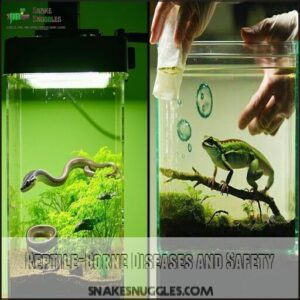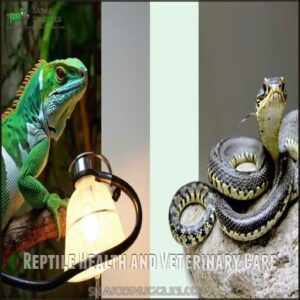This site is supported by our readers. We may earn a commission, at no cost to you, if you purchase through links.

Snakes are mostly low-maintenance—they don’t need daily feeding, and their housing is fairly simple.
Lizards, however, offer more interaction since many enjoy hand-feeding or exploring your shoulder like a tiny adventurer.
Snakes tend to be quieter and less active, while lizards can keep you entertained with their quirky climbing or basking behaviors.
Both need proper heat, light, and care, but space requirements and diets vary, and it’s all about matching their needs with your lifestyle.
Curious about reptiles’ unique behaviors? There’s more to uncover, especially their ability to be reptile companion.
Table Of Contents
- Key Takeaways
- Choosing Between Snakes and Lizards
- Specialized Care for Snakes
- Specialized Care for Lizards
- Reptile Welfare and Ethics
- Reptile-Borne Diseases and Safety
- Snakes as Pets
- Lizards as Pets
- Reptile Companionship and Entertainment
- Reptile Health and Veterinary Care
- Preparing for Reptile Ownership
- Frequently Asked Questions (FAQs)
- Are snakes easier than lizards?
- What is the friendliest reptile pet?
- Who is more poisonous, a snake or a lizard?
- Who would win, snake or lizard?
- Who would win, a snake or a lizard?
- Can you trust a snake as a pet?
- What is the best class pet for a reptile?
- Are snakes easier to care for than lizards?
- What is the best pet reptile for handling?
- Who would win, a lizard or a snake?
- Conclusion
Key Takeaways
- Snakes are low-maintenance pets with simple habitats and weekly feeding, while lizards need daily attention, UV lighting, and more complex care.
- Lizards are more interactive and active during the day, offering fun behaviors like climbing, while snakes are calmer and less demanding.
- Both reptiles require proper temperature, humidity, and species-specific diets for health, but snakes are often better for beginners due to their straightforward care.
- Choose between a snake and a lizard based on your lifestyle, available time, and willingness to handle species-specific needs.
Choosing Between Snakes and Lizards
You’ll need to weigh both the 15-30 year commitment and your lifestyle preferences when choosing between snakes and lizards as pets.
Snakes generally require less daily maintenance with weekly feeding schedules, while lizards offer more active daytime behavior but need more frequent feeding and specialized lighting for their health, which is a key consideration for their health.
Snakes are low maintenance, while lizards shine with active behavior, frequent feeding, and essential specialized lighting for thriving health.
Pros and Cons of Pet Snakes
Slithering into snake ownership brings both rewards and challenges worth considering before making your commitment.
Pet snakes offer distinct advantages that make them appealing to many reptile enthusiasts:
- Low maintenance requirements – Most species eat just once weekly and don’t need daily attention, fitting perfectly into busy lifestyles
- Simplified habitat needs – Basic snake care revolves around proper heating, adequate hiding spots, and appropriate substrate
- Generally calm temperament – Popular species like ball pythons and corn snakes typically handle well with regular interaction
The snake diet of whole prey animals isn’t for everyone, and their impressive lifespan (15-30 years) demands serious commitment.
While initial costs vary by species, ongoing expenses remain relatively affordable compared to traditional pets.
Snake habitat requirements are straightforward, though proper enclosure size becomes essential as your pet grows.
Pros and Cons of Pet Lizards
Pet lizards offer a vibrant window into the reptile world, though they come with distinct advantages and challenges.
Pros:
- Fascinating activity levels that provide daily entertainment
- Diverse lizard diet options from insects to vegetables
- Opportunity to create elaborate lizard habitats with climbing features
- Many species recognize owners after consistent handling
Cons:
- Higher maintenance with more frequent feeding schedules
- Enclosure complexity requires UV lighting and temperature gradients
- Greater handling difficulty with some skittish species
- Need for specialized veterinary access for reptile pets
- Longer commitment (15-20 years) with higher ongoing lizard care costs
To guarantee their well-being, remember temperature and humidity control is vital.
Comparison of Snake and Lizard Care
When comparing snake and lizard care, you’ll discover fundamental differences across their daily needs.
Snake care typically offers lower maintenance with weekly feeding schedules and straightforward dietary requirements—primarily pre-killed rodents.
Lizards present more complex care requirements:
- Dietary differences: Lizards need varied diets including insects, vegetables, and fruits
- Lighting needs: Special UVB lighting for calcium absorption
- Handling ease: Many lizards require more frequent interaction
Both reptiles share similar veterinary access challenges, though temperament variations exist between species.
Snakes generally tolerate brief handling sessions, while lizards might require gentler approaches.
For beginners, snake care often proves more approachable with simpler enclosure needs, though both reptiles represent a 15-20 year commitment—making either choice a long-term responsibility.
Space and Housing Requirements for Snakes and Lizards
When choosing a reptile companion, understanding their housing needs is essential for their well-being.
Your snake’s habitat should be at least as long as their body, while lizard terrariums require more width and climbing space.
Here’s what each reptile needs:
- Tank Size: Snakes need horizontal space; lizards need both floor space and height
- Enclosure Enrichment: Snakes enjoy simple hides; lizards thrive with branches, rocks, and climbing structures
- Heating Needs: Both require heat sources, but lizards often need additional UVB lighting that snakes don’t
Remember, proper humidity levels and substrate options vary substantially between species, so research your specific pet’s requirements.
Selecting the appropriate tank dimensions is imperative for your snake’s health.
It is crucial to consider these factors to ensure you provide the best environment for your reptile, focusing on their specific housing needs and heating requirements.
Specialized Care for Snakes
You’ll need to maintain specific temperature, humidity, and lighting conditions for your snake to thrive, just as you’d create the perfect environment for any specialized pet.
Your slithery friend will also require regular feeding with appropriate prey items, proper handling techniques, and vigilant monitoring for common health issues that can affect captive snakes.
Temperature, Humidity, and Lighting Needs
Once you’ve welcomed your scaly friend home, mastering their climate needs becomes your next adventure.
Snake habitats require precise heating gradients from 75-95°F, mimicking their natural environment. Set up a warm side with reptile heating pads or lamps, while keeping the opposite end cooler for temperature regulation.
Most snakes thrive at humidity levels between 50-60%. You’ll want to monitor this with a reliable gauge and maintain it using a proper water dish and occasional misting for proper reptile humidity control.
Unlike their lizard cousins who need UVB lighting and basking spots, many snakes don’t require special UV exposure. However, they do benefit from a consistent 12-hour light cycle to regulate their biological rhythms.
Don’t forget to check night temperatures to make certain they don’t drop too low when the lights go out! Many owners find under tank heaters to be very effective.
Feeding and Nutrition for Pet Snakes
Now that your temperature and humidity levels are dialed in, feeding your snake becomes a simpler part of care. As carnivorous creatures, snakes thrive on a straightforward diet of whole prey items.
Your snake’s feeding frequency depends on age – juveniles need meals twice weekly, while adults typically eat every 7-14 days. Choose prey types that match your snake’s size (no wider than the thickest part of their body).
Always opt for frozen-thawed rather than live prey to prevent injury to your pet snake. Thaw items in the refrigerator overnight – never in the microwave!
- Pinkies are perfect starter foods for young or smaller snake species
- Rats provide more nutritional value than mice for larger snakes
- Occasional vitamin supplementation helps prevent nutritional deficiencies
Watch for signs of obesity by monitoring your snake’s body condition regularly. Ensure a balanced diet to maintain your snake’s overall health, focusing on a straightforward diet of whole prey items.
Handling and Socialization for Snakes
Handling snakes might seem intimidating, but it’s all about confidence and understanding snake temperament. Start slow—short, gentle interactions help build trust. Always support their entire body, as dangling can stress them out, and stick with predictable, calm movements.
A key aspect is understanding species-specific handling to guarantee their comfort.
| Stage | Time | Techniques |
|---|---|---|
| Intro Sessions | Weeks 1–2 | Use tools like hooks, limit to 5 min |
| Trust Development | Weeks 3–4 | Begin light touches; avoid sudden moves |
| Comfortable Handling | Month 2+ | Full-body support, confident handling |
Recognizing stress, like hissing or coiling, guarantees safe handling. Keep it chill—snake behavior thrives on quiet confidence.
Health Risks and Common Diseases in Snakes
Snake troubles may slither in silently, but staying alert keeps your pet healthy and happy.
From respiratory infections to parasites, knowing the potential health risks helps you act fast.
Here are five common snake health issues to watch for:
- Respiratory Infections – Look for wheezing, bubbles near the nostrils, or open-mouth breathing. Improper humidity often triggers this.
- Scale Rot – Red, blistered scales from excessive moisture mean it’s time to adjust the habitat.
- Nidoviruses – Symptoms like labored breathing and poor appetite could indicate this serious condition.
- Mouth Rot – Swollen gums, pus, or discharge signal bacterial infection needing treatment.
- Parasites – Weight loss despite eating regularly? Parasites could lurk unseen.
To prevent these reptile health issues, maintain proper temperature, clean enclosures often, and schedule regular vet visits.
Healthy pet snakes thrive with clear eyes and smooth, shiny scales!
Specialized Care for Lizards
Caring for lizards means focusing on their specific needs, from proper UVB lighting to a well-balanced diet.
You’ll also need to keep a close eye on temperature and humidity levels to guarantee they stay healthy and active.
Feeding and Nutrition for Pet Lizards
Lizards have unique tastes, with some enjoying insects, others loving veggies, and many preferring both. A balanced pet lizard diet keeps them thriving.
Juvenile lizards usually eat every 2–3 days, while adults are content with 1–2 meals a week.
To avoid issues like obesity, vary meals with greens, mealworms, or crickets. Don’t skip Insect Gutloading—feed insects nutritious items before offering them to your lizard for better reptile nutrition.
You can find a variety of options for reptile dietary needs. Calcium Supplementation is essential too; sprinkle it over food to maintain strong bones, especially for non-vegetarian lizards.
Effective hydration methods include misting tanks for water-drinkers or providing a shallow bowl to keep your exotic pet diet healthy and balanced.
Handling and Socialization for Lizards
Getting comfortable with lizard handling requires patience, routine, and an eye for lizard temperament. Socializing your pet lizard can feel like building trust with a shy friend—it takes time but pays off.
Follow these tips:
- Handle them daily for 5-10 minutes, steering clear of meal times.
- Support their body fully—use a towel if they’re squirmy for safe handling.
- Sit on the floor to avoid injuries during reptile socialization.
- Be consistent with routines. Predictability helps calm their instincts, boosting bonding potential.
Read their body language to recognize signals and keep sessions enjoyable!
Health Risks and Common Diseases in Lizards
Caring for your pet lizard means staying ahead of health issues that could arise.
Common reptile diseases like Metabolic Bone Disease, Respiratory Infections, and Skin Infections often pop up due to preventable mistakes.
If your lizard shows signs like soft bones, tail rot, or wheezing, act fast—these could signal Metabolic Bone Disease or respiratory trouble, often tied to incorrect UVB lighting or temperatures.
Parasite prevention is another biggie, as parasites like mites or worms can cause weight loss and lethargy.
Good hygiene helps a lot here!
Even poor skin conditions, like scale rot, can result from a bad habitat setup.
Regular cleanings and proper nutrition truly keep exotic pet health on point, and good hygiene is crucial in preventing these issues, along with preventable mistakes and maintaining the right UVB lighting.
Reptile Welfare and Ethics
When you bring a snake or lizard into your home, it’s important to think about their welfare and the ethics of keeping them as pets.
By choosing responsible breeders and understanding their needs, you can guarantee a healthy, respectful life for your scaly companion.
The Pet Reptile Trade and Animal Welfare
Ethical sourcing makes a world of difference regarding reptile welfare.
Ethical sourcing transforms reptile ownership, supporting conservation while ensuring healthier, well-adjusted pets for a meaningful, responsible commitment.
Opt for captive-bred reptiles to support species conservation and avoid the harm caused by wild capture. Captive breeding helps protect ecosystems and guarantees your pet arrives healthier and better adjusted.
By choosing breeders committed to humane practices, you’re fighting reptile illegal trade and abuse.
Plus, backing reptile conservation groups lets you protect these fascinating creatures even further.
- **Did you know?
** Buying wild-caught pets can destroy habitats and harm entire species—you’ve got the power to change that.
Reptile Abuse and Neglect
Reptile abuse doesn’t always involve direct harm—it often stems from misinformation.
Improper housing, neglectful husbandry, and inadequate nutrition are common signs of reptile neglect.
Worse yet, illegal trading and veterinary neglect expose reptiles to abandonment issues and suffering.
Abuse may involve intentional harm, physical trauma, or overcrowding, leaving these creatures defenseless.
Watch for warning signs like inadequate habitats or improper handling.
If you notice reptile neglect, report it to animal welfare authorities to guarantee proper care and justice.
Responsible Reptile Ownership
Bringing a reptile into your home is more than just an exciting new hobby – it’s a long-term pledge.
Responsible reptile ownership hinges on these five basics:
- Source your pet ethically from reputable breeders to support conservation efforts.
- Set up a proper enclosure with heating, humidity, and space to match their natural habitat.
- Prioritize veterinary access for health checks and emergencies.
- Study their enrichment needs, including diet, handling, and stimulation.
- Commit to daily habitat care, promoting reptile longevity and health.
Respecting their unique needs guarantees a thriving, happy, and long-living scaly companion.
Supporting Reptile Welfare Organizations
Supporting reptile welfare groups is like voting with your time, money, and heart.
These organizations tackle issues like rescue vs. breeder practices and habitat preservation while advocating for ethical sourcing and better legislation.
| Organization | How You Can Help |
|---|---|
| Rescue Centers | Donate supplies |
| Advocacy Groups | Volunteer or sign petitions |
| Education Teams | Share public education posts |
| Conservationists | Fund habitat preservation |
| Sanctuaries | Contribute reptile donations |
Your small actions—like donating or fostering—directly impact reptiles through better housing, food, and veterinary care.
Volunteering at reptile sanctuaries connects you with reptile conservation groups, creating a ripple effect of change.
Reptile-Borne Diseases and Safety
Keeping reptiles as pets means understanding the risks of diseases like Salmonella, which they can carry naturally.
With proper hygiene and simple safety steps, you can enjoy their company without compromising your health.
Salmonella and Other Reptile-Borne Diseases
Caring for reptiles comes with some shared health risks.
Many reptiles carry zoonotic bacteria that can quietly spread to humans, even when the animal looks perfectly healthy. Salmonella tops the list, often linked to over 100 U.S. illnesses between 2022 and 2024. But it doesn’t stop there.
Here are key reptile-borne health facts:
- Salmonella Prevention: Reptiles naturally shed this bacteria, affecting humans through direct contact or contaminated surfaces.
- Zoonotic Risks: Pathogens like Campylobacter or Mycobacterium might hitch a ride silently.
- Disease Symptoms: Infections may include diarrhea, fever, or cramps.
- Reptile Hygiene: Routine cleaning reduces exposure to reptile health issues.
Preventing The Spread of Reptile-Borne Diseases
Understanding reptileborne diseases like Salmonella is important to protect your health and your pet’s.
Staying safe starts with good hygiene practices. Wash your hands thoroughly with soap and warm water for 20 seconds after handling your reptile, cleaning its habitat, or any contact with its food.
| Prevention Method | Snake Owners | Lizard Owners | Frequency |
|---|---|---|---|
| Hand Washing | After every touch | After every touch | Always |
| Cage Cleaning | Weekly deep clean | Weekly deep clean | Weekly |
| Food Prep | Separate tools | Separate tools | Every meal |
| Vet Checkups | Every 6-12 months | Every 6-12 months | Annually |
Avoid using your kitchen sink for reptile chores. Utilize separate supplies to maintain proper reptile hygiene.
Routine veterinary checks help catch potential reptile health issues early, ensuring everyone stays safe and healthy!
Safety Precautions for Handling Reptiles
Keeping yourself and your reptile safe during handling isn’t complicated, but it does require some care.
Reptiles can carry bacteria like Salmonella, so maintaining good hand hygiene is critical. Always wash your hands before and after handling to avoid illness.
Here are smart safety practices to follow:
- Use proper restraint like snake hooks for larger or nervous snakes.
- Wear gloves when cleaning habitats—bacteria don’t take holidays!
- Watch body language—hissing or tail whipping means it’s time to back off.
- Keep handling sessions calm and short.
- Secure enclosures safely after every interaction to prevent escape.
With these tips, reptile handling becomes safer and stress-free for everyone.
Vaccinations and Health Checks for Reptiles
Unlike cats or dogs, reptiles don’t need vaccinations, but regular checkups are essential for keeping your scaly friend healthy.
Routine reptile health checks help spot issues like parasites, metabolic bone disease, or infections—problems that can sneak up on you without warning.
Expect fecal tests, blood work, and a physical exam during visits.
At home, monitor your pet’s eating habits, shedding, and behavior closely.
New pets? Practice quarantine protocols to prevent spreading parasites.
Think of these steps as reptile preventative care—a little effort in veterinary care guarantees better health screening and happier years for your reptile.
Snakes as Pets
If you’re looking for a low-maintenance, fascinating pet, snakes might be a perfect match.
With their calm demeanor and minimal care needs, these scaly companions can fit into many lifestyles effortlessly.
Popular Pet Snake Species
Looking for low-maintenance, beginner-friendly pet snakes? Here are some great options to explore:
- Ball Pythons: These gentle giants are known for their calm demeanor and compact size, making them a cozy fit for smaller setups. Plus, their diversity in color patterns is stunning.
- Corn Snakes: Vibrant, easygoing, and adaptable, corn snakes are a top choice for first-time owners. They’re a breeze to handle and care for.
- King Snakes: Hardy and fascinating, these snake species stay manageable in size and are as low-maintenance as it gets.
Pet snakes make enchanting companions!
Snake Behavior and Body Language
A snake’s body language is like a secret code—it reveals its mood, needs, and even health.
For instance, frequent tongue flicks signal exploration or curiosity, while S-shaped postures mean, “Stay back!” Relaxed, smooth movements? That’s a snake’s way of saying it feels secure.
Stressful moments, like shedding behavior, may make them dull-eyed or sluggish.
Here’s a quick guide to common signals:
Behavior What It Means How to Respond
Learning to interpret snake behavior helps you build trust, manage stress cues, and understand reptile body language better than ever!
Snake Handling and Training
Understanding your snake’s temperament is the first step to mastering safe handling.
Support its body fully and move slowly—calm movements build trust. Short, frequent sessions work best for reptile taming, starting with five minutes and slowly increasing over time. Keep an eye out for stress signals like hissing or tight coiling, and stop if your snake seems uneasy.
Building confidence with pet snake handling takes consistency, patience, and recognizing stress cues. Over time, you’ll see them adapt to your presence, making handling frequency more enjoyable for both of you.
- Rewards of Handling: A relaxed, confident snake.
- Behaviors to Avoid: Grabbing unexpectedly or loud movements.
- What Handling Builds: Trust, familiarity, and stress-free bonding.
Common Health Issues in Pet Snakes
Keeping a close eye on snake health is essential for a happy, thriving pet.
Many common issues are preventable with proper care, so let’s get started:
- Scale Rot – A painful skin infection caused by excessive humidity. Make certain the enclosure stays clean and dry.
- Respiratory Infections – Symptoms include wheezing or bubbling nostrils, often tied to inadequate heating or humidity.
- Parasites – Mites or internal worms can trigger weight loss and discomfort. Quarantine new snakes to avoid infestations.
- Obesity – Overfeeding leads to serious health risks. Stick to proper feeding schedules.
Refusing food, lethargy, or regurgitation may signal illness. Controlling habitat conditions improves reptile health and prevents costly vet trips.
Lizards as Pets
If you’re looking for a lively companion, lizards offer plenty of personality with their active behavior and unique appearance.
From geckos to iguanas, these reptiles come in various species, each with specific care needs that you’ll want to explore before bringing one home, considering their unique characteristics.
Popular Pet Lizard Species
Choosing the best pet lizard depends on your lifestyle and care preferences.
Each species has unique traits, making them fascinating companions.
- Bearded Dragons: These friendly reptiles love attention and can recognize their owners, making them perfect starter pets.
- Leopard Geckos: Active at night, they’re easy to care for, requiring minimal lighting and showing fun hunting behaviors.
- Crested Geckos: Velcro-toed climbers thrive on fruit-based diets and don’t need UV light.
- Blue-Tongued Skinks: Known for their signature blue tongues and curious nature, they’re gentle and easygoing.
- Green Anoles: Small, energetic, and color-changing based on mood or temperature.
- Uromastyx: Vegetarian "living fossils" with calm personalities who thrive in warm, dry enclosures.
Consider each lizard species’ needs, including diet, enclosure setup, and lifespan, to find your perfect fit!
Lizard Behavior and Body Language
Your lizard’s body language is like its personal toolkit for communication, silently sharing its mood, comfort, or stress. Recognizing these social signals builds trust and makes your reptile handling experience smoother.
When your lizard closes its eyes near you, it’s saying, “I trust you.” Rapid tail movements often signal stress or excitement, while slow arm waving is a polite, “I mean no harm.” Some behaviors, like basking or flattening their body, indicate relaxation, while darkening skin may mean stress or just adjusting to temperature.
| Behavior | Meaning | Response |
|---|---|---|
| Head bobbing | Showing dominance | Give space |
| Tail dropping | Stress/defense (Tail Autotomy) | Don’t startle them |
Every lizard species has unique reptile behavior quirks. Bearded dragons puff blackened beards in warning, and geckos might vocalize softly. Watching these silent cues enriches your connection, helping you understand their personal toolkit for communication and builds a stronger bond through reptile handling.
Lizard Handling and Training
Handling your lizard starts with understanding their temperament and building trust.
Gentle reptile handling minimizes stress and fosters a bond.
Follow these steps for safe and effective pet lizard handling:
- Hold daily 5-minute sessions—short durations prevent overstimulation.
- Use proper handling techniques—always support the body, focusing on the belly and tail.
- Incorporate training methods—reward calm behavior with treats to create positive associations.
Consistency transforms exotic pet handling into a rewarding experience for both you and your reptile.
Common Health Issues in Pet Lizards
In the context of lizard health, most problems tie back to improper care.
Metabolic Bone Disease is a top concern, caused by poor UVB lighting or a lack of calcium, leaving your lizard with fragile bones.
Respiratory infections, or respiratory disease, can show up as wheezing or nasal bubbles—often due to fluctuating temperatures.
Parasite prevention is key, as poor hygiene can lead to infestations or scale rot.
Watch for thermal burns from misplaced heat sources, dehydration (sunken eyes, wrinkled skin), and shedding problems.
Even tail rot can develop without proper environment maintenance.
By nailing your setup and keeping an eye out, you’ll dodge reptile health pitfalls like a pro.
Reptile Companionship and Entertainment
In the context of reptile companionship, snakes and lizards offer unique ways to keep you entertained.
From observing a snake’s graceful movements to watching a lizard’s curious antics, these reptiles bring fascinating behaviors into your home.
Building a Bond With Your Reptile
Building a bond with your reptile is like earning trust from a thoughtful, quiet companion.
While reptiles aren’t affectionate like dogs, they exhibit connection through subtle behaviors.
Practice these steps:
- Use proper reptile handling techniques: Start with short, five-minute sessions and gradually extend as your reptile shows calmness and trust.
- Study behavioral cues: Watch for signs like relaxed movements or gentle curiosity—your pet’s way of saying "I’m comfortable."
- Consistency builds security: Engage daily, creating a predictable routine that reassures your pet.
Reptile bonding thrives on patience, respect, and understanding their unique rhythms.
Providing Mental Stimulation for Reptiles
Your reptile deserves mental workouts to match their physical care.
Engage your scaly buddy with activities that reflect their natural instincts. Use puzzle feeders for snakes or create live insect hunts for lizards during meals.
Offer sensory stimulation with varied substrates or digging boxes, and set up mazes for cognitive fun. Fresh hides and climbing branches encourage reptile natural behavior encouragement, while brief handling can enhance their comfort with you.
Remember to maintain humidity and temperature to prevent respiratory infections.
Keep it interesting—switch up activities often. By applying these enrichment techniques, you’ll boost their well-being and enjoy seeing their unique reptile engaging behavior shine.
Creating a Reptile-Friendly Environment
Creating a reptile-friendly environment is like designing a miniature world customized for your scaly friend.
Start with proper temperature gradients and humidity control; use heating lamps, mist systems, or water dishes to match their natural habitat.
Choose substrate options that suit their species, like mulch or paper, and add enrichment items—branches, climbing structures, and caves—to encourage natural behaviors.
Include secure hiding spots for stress relief and open areas for exploration, ensuring a reptile environment setup that guarantees health, comfort, and a vibrant reptile habitat.
Reptile Behavior and Socialization
Understanding reptile behavior reveals a unique world of companionship.
While reptiles aren’t cuddly, their social behavior can surprise you. Recognizing owners and responding to handling frequency builds trust.
- Snake intelligence shows in tongue flicking—how they “taste” their surroundings.
- Calm snake behavior involves slow, smooth movements when relaxed.
- Curious lizard behavior is easy to spot when they tilt their heads at you.
- Behavioral enrichment like climbing branches benefits all species.
- Reptile socialization techniques, such as gentle handling, help them feel secure.
Patience and observation reveal how entertaining these animals truly are!
Reptile Health and Veterinary Care
Keeping your pet snake or lizard healthy means finding a vet who specializes in reptiles and understanding their unique medical needs.
Regular check-ups, proper care, and knowing when to act in emergencies can make all the difference for your scaly companion, as regular check-ups are crucial.
Finding a Reptile-Specialized Veterinarian
Finding the right vet for reptiles isn’t as simple as walking into the nearest clinic. Most general vets lack training in specialized reptile veterinary care.
Make use of ARAV’s “Find A Vet” tool, and always verify credentials. You’ll often need to travel longer distances, but it’s worth it for your scaly pal’s health.
Reptile owners should also consider verifying vet certifications to guarantee expertise in herpetological medicine.
Here’s a quick comparison:
| Resource | What to Check | Why It Matters |
|---|---|---|
| ARAV Directory | Certification | Guarantees reptile experience |
| Local Clubs | Vet recommendations | Trusted reptile-care tips |
| Vet Clinics | Diagnostic equipment | Accurate health monitoring |
Investing time in finding specialists guarantees preventative care, better health monitoring, and peace of mind.
Common Health Issues in Reptiles
Keeping an eye on your reptile’s health can help you avoid serious issues.
Pet snake health and pet lizard health often share common problems.
Here are five to watch for:
- Scale rot: Damaged, discolored scales often caused by too much humidity.
- Respiratory infections: Symptoms include wheezing, open-mouth breathing, or bubbles near nostrils.
- Parasite prevention: Watch for mites or worms causing weight loss and sluggish behavior.
- Metabolic bone disease: Lizards lacking calcium may develop weak bones or unusual posture.
- Dysecdysis: Trouble shedding skin, often linked to poor humidity.
Regular cleaning, proper temperatures, and balanced diets keep your reptile thriving.
Catch problems early—prevention’s the best medicine!
Preventative Care and Health Checks
Preventing health problems in reptiles is like having a well-tuned car—it keeps everything running smoothly. Whether it’s pet snake health or pet lizard health, sticking to good habits makes a big difference.
Here’s your reptile prevention checklist:
- Regular Checkups: Visit the vet 2-4 times a year. Early detection keeps shedding issues and other problems manageable.
- Parasite Prevention: Test for parasites regularly and treat promptly. A clean bill of health equals a happy reptile.
- Hygiene Practices: Clean the enclosure weekly to avoid bacteria like Salmonella. A tidy habitat is a healthy habitat.
- Hydration Importance: Proper humidity levels reduce stress and skin problems.
Don’t skip quarantine protocols—new reptiles need 30 days solo before mingling. It’s smart prevention that guarantees their long, cozy life.
Emergency Care for Reptiles
When disaster strikes, reptile emergency care starts with rapid trauma response. A reptile-specific first aid kit is essential for treating thermal burns, shedding issues, or minor injuries.
Be ready for emergencies like respiratory distress or prolapses—store your vet’s number and keep a transport container handy. For toxin exposure or parasite infestations, don’t delay—contact specialized veterinary care immediately.
Preparation isn’t optional; it’s your safety net. Think ahead, and your reptile will thank you (in its own way), emphasizing the importance of being prepared for any emergency.
Preparing for Reptile Ownership
Preparing for reptile ownership takes careful planning, research, and a realistic look at your resources.
You’ll need to set up the right habitat, budget for supplies, and be ready for a long-term commitment.
Researching Reptile Care and Needs
Before choosing a reptile, research is your top priority. Different species require customized care to thrive.
- Learn reptile species-specific needs, including their unique habitat setups, temperature, and humidity preferences.
- Understand reptile dietary requirements—think whole prey for snakes or varied diets for lizards.
- Explore behavioral analysis to know how they interact with humans.
- Focus on health monitoring to catch issues early.
- Explore reptile care forums for real-life advice.
Preparation guarantees smooth sailing when your new scaly friend arrives, and it’s key to smooth sailing with your new pet, ensuring you can provide the best customized care.
Setting Up a Reptile-Friendly Environment
Creating a cozy reptile habitat setup starts with a spacious tank size—snakes thrive in length, while lizards need height and width to explore.
Add heating solutions like heat lamps or mats to maintain warmth, and don’t forget UVB lighting for lizards.
Substrate options, such as mulch or paper towels, help with humidity control, essential for a healthy reptile enclosure.
Enrichment items like branches, hides, and water dishes make their reptile terrarium feel like home.
Verify proper temperature gradients for natural heat regulation and a happy reptile environment, ensuring a healthy reptile enclosure.
Budgeting for Reptile Care and Supplies
Setting up your reptile’s habitat means balancing initial costs and recurring expenses.
Snake enclosures are simpler and cheaper than lizard terrariums. Expect these costs:
- $200–$500 for setup costs like tanks and heating.
- Recurring expenses: $5–$15 weekly for snake food or smaller budgets for lizards.
- DIY supplies can save money if you’re crafty.
- A vet fund is essential—emergency visits typically range $100–$200.
Remember that you’ll need to factor in essential equipment costs like hides and foliage.
Budget smartly to keep both wallet and pet happy!
Preparing for The Long-Term Commitment of Reptile Ownership
When bringing an exotic pet into your life, you’re signing up for a long partnership – often lasting 10 to 30 years.
Reptiles require thoughtful planning to guarantee they thrive in your care.
Ask yourself:
- **Can I commit to their lifespan?
Some reptiles outlive dogs!
- **Am I ready for the costs?
Think habitat upgrades, heat lamps, vet visits, and more.
- **Do I’ve space?
Tanks for larger species can dominate a room.
- **How will life changes affect care?
Moving or traveling demands preparation.
- **Is this choice legal?
Laws vary for certain species.
Financial planning sets the stage for happy reptile care!
Frequently Asked Questions (FAQs)
Are snakes easier than lizards?
Snakes are generally easier than lizards.
They eat less often, require simpler habitats, and don’t need daily interaction.
Unlike lizards, snakes don’t need UV lighting, making their care less time-intensive and more straightforward.
What is the friendliest reptile pet?
Let’s face it, a reptile won’t wag its tail in joy, but leopard geckos come close.
They’re docile, easy to handle, and even seem to smile.
If you’re new to reptiles, they’re perfect!
Who is more poisonous, a snake or a lizard?
In general, snakes are more venomous than lizards, with some species like cobras packing deadly venom.
While a few lizards, like the Gila monster, are venomous, they’re far less dangerous compared to venomous snakes.
Who would win, snake or lizard?
Picture a swift lizard dodging while a snake coils, both armed for survival.
Who’d win? It depends—size, speed, and venom matter.
Generally, snakes overpower most lizards, but some lizards outwit with agility or armor.
Who would win, a snake or a lizard?
It depends on the species and size. A larger snake could overpower a smaller lizard, but some agile lizards, like monitors, might outmaneuver a snake. Nature always factors in surprises!
Can you trust a snake as a pet?
You can trust pet snakes when they’re handled properly and given care.
They’re not emotional companions, but they’re predictable if treated right.
Wash your hands after handling—a snake’s trust isn’t personal, but it’s manageable.
What is the best class pet for a reptile?
A lizard like a leopard gecko makes a great class pet.
They’re low-maintenance, quiet, and fun to observe.
Plus, their manageable size and friendly nature make them easy for kids to get excited about!
Are snakes easier to care for than lizards?
Caring for a snake is like managing a low-maintenance roommate—simple meals, minimal fuss, and quiet company.
Lizards, meanwhile, demand more effort with varied diets, UV lighting, and daily attention.
Snakes often steal the "easier" title.
What is the best pet reptile for handling?
The best reptile for handling is the ball python. It’s calm, slow-moving, and tolerates interaction well.
If you prefer a lizard, consider a bearded dragon—they’re friendly, easygoing, and often enjoy sitting on your shoulder.
Who would win, a lizard or a snake?
Like a chess match, it depends on the players.
Snakes have strength and agility, while lizards rely on speed and dexterity.
In real life, outcomes vary by species, size, and environment.
Conclusion
Picture your decision like choosing between two adventure buddies: a laid-back, quiet observer or an active, curious explorer.
Snakes, with their simplicity and low-maintenance care, are perfect if you prefer calm companionship.
Lizards, on the other hand, bring interactive fun and quirky antics to your day.
When comparing pet snakes vs pet lizards, think about your lifestyle, commitment, and preferences.
Whichever you choose, providing proper care guarantees a rewarding bond with your unique reptile companion.
- https://onlinelibrary.wiley.com/doi/abs/10.1111/j.1439-0396.2010.01011.x
- https://www.sciencedirect.com/science/article/pii/S0042682217304130?via%3Dihub
- http://www.reptilesmagazine.com/Lizards/5-Great-Beginner-Pet-Lizards/
- https://planetchinchilla.com/
- https://community.morphmarket.com/t/ihs-reptile-show-and-budgetting/40482





















